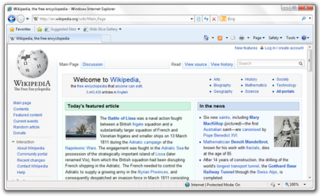
Internet Explorer is a deprecated series of graphical web browsers developed by Microsoft that were used in the Windows line of operating systems. While IE has been discontinued on most Windows editions, it remains supported on certain editions of Windows, such as Windows 10 LTSB/LTSC. Starting in 1995, it was first released as part of the add-on package Plus! for Windows 95 that year. Later versions were available as free downloads or in-service packs and included in the original equipment manufacturer (OEM) service releases of Windows 95 and later versions of Windows. Microsoft spent over US$100 million per year on Internet Explorer in the late 1990s, with over 1,000 people involved in the project by 1999. New feature development for the browser was discontinued in 2016 in favor of its successor, Microsoft Edge.
Extensible Application Markup Language is a declarative XML-based language developed by Microsoft for initializing structured values and objects. It is available under Microsoft's Open Specification Promise.
Trident is a proprietary browser engine for the Microsoft Windows version of Internet Explorer, developed by Microsoft.

Microsoft Blend for Visual Studio is a user interface design tool developed and sold by Microsoft for creating graphical interfaces for web and desktop applications that blend the features of these two types of applications. It is an interactive, WYSIWYG front-end for designing XAML-based interfaces for Windows Presentation Foundation, Silverlight and UWP applications. It was one of the applications in the Microsoft Expression Studio suite before that suite was discontinued.
Windows Presentation Foundation (WPF) is a free and open-source graphical subsystem originally developed by Microsoft for rendering user interfaces in Windows-based applications. WPF, previously known as "Avalon", was initially released as part of .NET Framework 3.0 in 2006. WPF uses DirectX and attempts to provide a consistent programming model for building applications. It separates the user interface from business logic, and resembles similar XML-oriented object models, such as those implemented in XUL and SVG.

Internet Explorer Mobile is a mobile version of Internet Explorer developed by Microsoft, based on versions of the MSHTML (Trident) layout engine. IE Mobile comes loaded by default with Windows Phone and Windows CE. Later versions of Internet Explorer Mobile are based on the desktop version of Internet Explorer. Older versions however, called Pocket Internet Explorer, are not based on the same layout engine.

Microsoft's Professional Developers Conference (PDC) was a series of conferences for software developers; the conference was held infrequently to coincide with beta releases of the Windows operating system, and showcased topics of interest to those developing hardware and software for the new version of Windows.

Live Connect is a collection of APIs and common controls that allow developers to have a deeper control and offers access to the core Windows Live services and data through open and easily accessible application programming interfaces (APIs). At MIX07, Microsoft's Senior Architect Danny Thorpe described:
[The Windows Live Platform] today can combine video, photos, contacts, maps, and search into web applications. Users can drop web controls into the web applications with just a few lines of JavaScript and be up and running in a matter of minutes, and they can dive a little deeper to access service APIs directly and define their own UI and process flow. Users have control over what applications can access their private data, and can revoke that access at any time.

Microsoft Silverlight is a discontinued application framework designed for writing and running rich web applications, similar to Adobe's runtime, Adobe Flash. A plugin for Silverlight is still available for a very small number of browsers. While early versions of Silverlight focused on streaming media, later versions supported multimedia, graphics, and animation, and gave support to developers for CLI languages and development tools. Silverlight was one of the two application development platforms for Windows Phone, but web pages using Silverlight did not run on the Windows Phone or Windows Mobile versions of Internet Explorer, as there was no Silverlight plugin for Internet Explorer on those platforms.

Windows Internet Explorer 8 (IE8) is the eighth and, by now, discontinued version of the Internet Explorer web browser for Windows. It was released by Microsoft on March 19, 2009, as the successor to Internet Explorer 7. It was the default browser in Windows 7 and Windows Server 2008 R2.

Internet Explorer 9 or IE9 is the ninth version of the Internet Explorer web browser for Windows. It was released by Microsoft on March 14, 2011, as the ninth version of Internet Explorer and the successor to Internet Explorer 8. Microsoft released Internet Explorer 9 as a major out-of-band version that was not tied to the release schedule of any particular version of Windows, unlike previous versions. It is the first version of Internet Explorer not to be bundled with a Windows operating system, although some OEMs have installed it with Windows 7 on their PCs. Internet Explorer 9 is the last version that is called Windows Internet Explorer. The software was rebranded simply as Internet Explorer starting in 2012 with the release of Internet Explorer 10.

Visifire was a set of data visualization components. It currently supports Charts and Gauges. Visifire is available on Microsoft Silverlight, WPF, Windows Phone, and Windows 8. One can use the same API to create charts and gauges in mobile, web, and desktop environments. Visifire can also be embedded in any webpage as a standalone Silverlight App. It is independent of the server side technology being used. Hence, Visifire can be used with ASP, ASP.NET, PHP, JSP, ColdFusion, Ruby on Rails or just simple HTML with JavaScript.

Deep Zoom is a technology developed by Microsoft for efficiently transmitting and viewing images. It allows users to pan around and zoom in a large, high resolution image or a large collection of images. It reduces the time required for initial load by downloading only the region being viewed or only at the resolution it is displayed at. Subsequent regions are downloaded as the user pans to them; animations are used to hide any jerkiness in the transition. The libraries are also available in other platforms including Java and Flash.
XAML Browser Applications are Windows Presentation Foundation (.xbap) applications that are hosted and run inside a web browser such as Firefox or Internet Explorer. Hosted applications run in a partial trust sandbox environment and are not given full access to the computer's resources like opening a new network connection or saving a file to the computer disk and not all WPF functionality is available. The hosted environment is intended to protect the computer from malicious applications; however it can also run in full trust mode by the client changing the permission. Starting an XBAP from an HTML page is seamless. Although one perceives the application running in the browser, it actually runs in an out-of-process executable (PresentationHost.exe) managed by a virtual machine. In the initial release of .NET Framework 3.0, XBAPs only ran in Internet Explorer. With the release of .NET Framework 3.5 SP1, which includes an XBAP extension, they also run in Mozilla Firefox.
Microsoft Device Emulator is an emulator for Windows Mobile-based devices. Microsoft Officially launched an emulator for Windows Mobile 6.5 in November 2008, The Windows Mobile 6.5 Developer Tool Kit adds various features for developing such as documentation, obtaining a sample code, header and library files, emulator images and tools to Visual Studio. The Microsoft Device Emulator is available in Simplified Chinese, English, German, French, Italian, Spanish, and Japanese. Independent from the Windows Mobile emulator Microsoft has also released an emulator for Internet Explorer Mobile for developers.
Seadragon Software was a team within the Microsoft Live Labs. Its product, Seadragon, is a web optimized visualization technology that allows graphics and photos to be smoothly browsed, regardless of their size. Seadragon is the technology powering Microsoft's Silverlight, Pivot, Photosynth and the standalone cross-platform Seadragon application for iPhone and iPad.

Internet Explorer 10 (IE10) is the tenth, and by now, discontinued, version of the Internet Explorer web browser and the successor to Internet Explorer 9, released by Microsoft on September 4, 2012, shortly after the completion of Windows Server 2012. It was the default browser that shipped with Windows 8 and Windows Server 2012 and can replace previous versions of Internet Explorer on Windows 7 and Windows Server 2008 R2 but unlike version 9, this version doesn't support Windows Vista, Windows Server 2008 or earlier.
Microsoft Silverlight is an application framework for writing and running rich web applications that was actively developed and marketed by Microsoft from 2007 to 2012. This is a technical overview of the platform's history.
Windows UI Library is a user interface API that is part of the Windows Runtime programming model that forms the backbone of Universal Windows Platform apps for the Windows 8, Windows 8.1, Windows 10 and Windows Phone 8.1 operating systems. It enables declaring user interfaces using Extensible Application Markup Language (XAML) technology.








